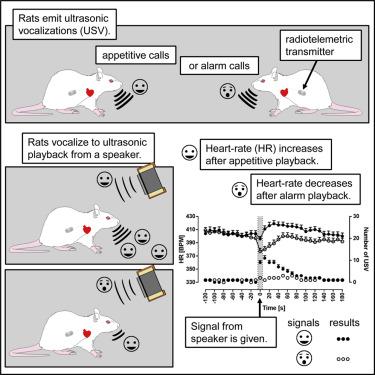iScience ( IF 4.6 ) Pub Date : 2020-09-19 , DOI: 10.1016/j.isci.2020.101577 Krzysztof H. Olszyński , Rafał Polowy , Monika Małż , Paweł M. Boguszewski , Robert K. Filipkowski

|
Our rudimentary knowledge about rat intraspecific vocal system of information exchange is limited by experimental models of communication. Rats emit 50-kHz ultrasonic vocalizations in appetitive states and 22-kHz ones in aversive states. Both affective states influence heart rate. We propose a behavioral model employing exposure to pre-recorded playbacks in home-cage-like conditions. Fifty-kHz playbacks elicited the most vocalizations (>60 calls per minute, mostly of 50-kHz type), increased heart rate, and locomotor activity. In contrast, 22-kHz playback led to abrupt decrease in heart rate and locomotor activity. Observed effects were more pronounced in singly housed rats compared with the paired housed group; they were stronger when evoked by natural playback than by corresponding artificial tones. Finally, we also observed correlations between the number of vocalizations, heart rate levels, and locomotor activity. The correlations were especially strong in response to 50-kHz playback.
中文翻译:

警报和有吸引力的呼叫的回放对大鼠的声音,心律和运动反应有不同的影响
我们关于大鼠种内人声系统信息交流的基础知识受到交流实验模型的限制。大鼠在食欲状态下发出50 kHz的超声波发声,在反感状态下发出22 kHz的发声。两种情感状态都会影响心率。我们提出了一种行为模型,该模型采用暴露于类似家庭笼子条件下的预先录制的播放的方式。五十kHz的回放引起最多的发声(每分钟> 60个呼叫,大多数为50 kHz的类型),心律增加和运动活动。相反,22 kHz的播放导致心率和运动能力突然下降。与成对饲养的组相比,在成年饲养的大鼠中观察到的效果更为明显。当自然播放引起它们时,它们比相应的人工音调更强。最后,我们还观察到发声次数,心率水平和运动活动之间的相关性。在响应50 kHz播放时,相关性特别强。









































 京公网安备 11010802027423号
京公网安备 11010802027423号